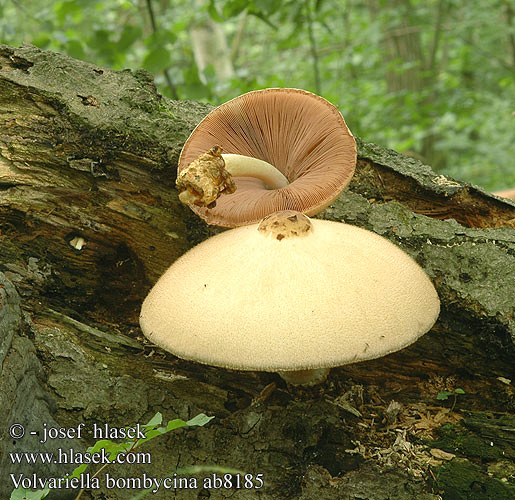Silky Rosegill: Red Data Book of Armenia

Category. EN – Endangered.
Brief description. Cap is from 7 to 25 cm across, which varies in colour from white to yellowish, yellowish–milky then light yellow– lemon–coloured. At first it is ball–shaped, then bell–shaped or semispread with a hillock. It is dry, velvety, consist hair–like fibres, slightly scaly, smooth in the centre. Flesh is white. It has nice mushroom taste. Gills are white, gradually pink, crowded, thin, thickened in the centre. Stipe is 8–25 x 1,5–2,5 cm long, white, central, sometimes curved, smooth, bulbous at the base, whitish. With large, up to 5 cm long, persistent, free, membranous volva. The outer surface of volva is white at first, then brownish, with wavy margins. Spore print is pink. Spores are 7–10 x 5–6 µm, light pink, oval–shaped, ovoid, even.
Distribution. Generally in Europe, Asia, Northern Africa, Northern America, Southern Caucasus (Azerbaijan, Georgia, Armenia). In Armenia it is discovered in Ijevan floristic region – in "Dilijan" National Park; in Yerevan floristic region – in the territory of Botanical garden.
Ecological, biological and phytocenological peculiarities. In Armenia it is rarely met, mainly in groups, on living and dead trunks and hollows of broad–leaved trees in broad–leaved forests (mainly on poplar, willow and beech trees), on the altitude of 1100–1450 m above sea level, from June to September. Xylotrophic fungi. Fruit bodies are edible. This is a decorative mushroom species.
Main factors of endangering. Loss of habitats, degradation and breakdown of ecosystems, reduction of forest areas caused by uncontrolled felling.
Nature conservation measures. In Armenia it is conserved in corresponding ecosystems of "Dilijan" National Park. It is necessary to carry out monitoring of the state of discovered species and discovery of new habitats.
Suggestions
 The Ministry of Environment sent a letter international partners to draw their attention to the real danger of environmental disasters as a result of Azerbaijan's large-scale aggression towards the territory of Armenia
The Ministry of Environment sent a letter international partners to draw their attention to the real danger of environmental disasters as a result of Azerbaijan's large-scale aggression towards the territory of Armenia
 Vicia pisiformis: Red Data Book of Armenia
Vicia pisiformis: Red Data Book of Armenia
 Vavilovia formosa: Red Data Book of Armenia
Vavilovia formosa: Red Data Book of Armenia
 Trigonella capitata: Red Data Book of Armenia
Trigonella capitata: Red Data Book of Armenia
 Trigonella astroides: Red Data Book of Armenia
Trigonella astroides: Red Data Book of Armenia












